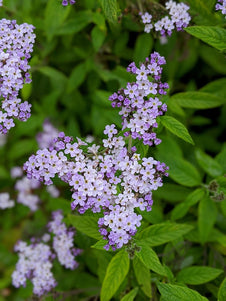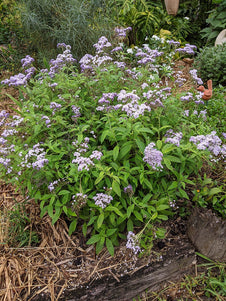





Heliotrope - Cherry Pie
Heliotrope - Cherry Pie

- In stock, ready to ship
- Inventory on the way

Usually available: All year
Life cycle: Perennial
Height: 60cm - 1m
Position: Sun / part shade
Soil preference: Well drained
This is how we pack and send your Herb Plants to all states except TAS & WA
You will receive
- 1 Heliotrope - Cherry Pie Herb Plant in a 50 X 75mm tube - General growing instructions
All of our Herb Plants are grown organically with certified organic potting mixes and fertilizers
Botanical Name: Heliotropium aborescens
Heliotrope ‘Cherry Pie’ is an evergreen shrub growing from 60-100cm high and sprawling up to 2 meters wide in good conditions. It may not reach this size in every garden. It has lush, elliptical shaped leaves of mid to dark green, sometimes with a purple cast. The leaves are quite wide and from 2.5 to 8 cm long, with obvious veins and a hairy texture. The flowers are purple removed and held in clusters of 2-4 cm in diameter. The scent is said to be similar to baked cherry pie and vanilla, which resulted in the common name.
Heliotrope is the name for many plants in the genus Heliotropium. The name Heliotropium is from the Greek for ‘the sun’ and ‘to turn’ which is an old reference to the flower’s perceived habit of turning towards the sun. The species name ‘arborescens’ means tree-like and the base of older plants may sometimes become quite woody. Heliotrope ‘Cherry Pie’ is originally a native of Peru and may be listed as H. peruvianum. It grows at elevations from sea level to 3500 meters in habitats ranging from forest to coastal locations.
In the 1757 the Heliotrope was introduced to European gardens, eventually becoming a Victorian era favourite. By the 19th century it was a popular garden bedding plant known for the intense fragrance. Some species have such an intense fragrance that they are used to make perfume and soaps in Europe. Others have had their fragrance sacrificed in line with plant breeding and development. While the fragrance once filled gardens, now it may be necessary to be quite close to some varieties to experience the true intensity of the scent.
Heliotrope is a member of the Boraginaceace family of plants with up to 250 species, all fragrant and good butterfly attractants. There are many different species in the Heliotropium genus from all over the world, so it is important to check the botanical name to ensure you have the correct plant. Usually Heliotrope ‘Cherry Pie’ (or Turnsole in the UK) and related varieties are the main plants available for home gardening. However, there is also a plant called Garden Heliotrope which is actually Valeriana officinalis. Another species H. europeaeum, or European Heliotrope, is often called Common Heliotrope in Australia. All parts of the Heliotropium are toxic and animal deaths have occurred from ingesting Heliotropium.
Growing Conditions
Heliotrope is happy to grow in full sun or part shade, although the Australian sun in hot areas may be too harsh in summer. Moist, light to sandy soil is preferred and plants that are too dry will have dry looking leaves. Despite coming from the sub-tropical region of the world, it does not like humidity or heavy, wet clay soils. Excessively rich and damp soil may also cause leggy growth. It is easily sown from seed or propagated by cuttings in spring.
It is cold hardy to about 5 degrees Celsius when in a pot, but plants if the ground may not survive temperatures at or below freezing because the roots will be killed. Regions with temperatures this low would be best to consider Heliotrope as an annual plant, rather than a tender perennial. It can be grown successfully as a house plant.
As the plant ages it may become leggy or straggly, so pruning or replanting becomes an option. Heliotrope does well in pots, as well as being a valuable ‘old fashioned’ addition to the garden.
Culinary Uses
Heliotrope has a history of use in traditional healing and magical folklore, but today it is not usually considered a culinary or medicinal plant. Much of the European folklore and early culinary use is likely to be related to the European Heliotrope, rather than the South American species. There are also many Heliotropes around the world, so there may be different uses for each.
Caution: Plants in the Heliotropium genus are toxic in varying degrees, due to the presence of pyrrolizidine alkaloids. These can act quickly or build up over time depending on the animal involved. The result may be significant, and often deadly, physiological and neurological symptoms in humans and animals. Skin irritation may also occur from handling the plant. It has traditionally been used as an infusion for sore throats and in homeopathy to cleanse the blood and lymph systems. Not for long term use.
All information provided on this website is for informational purposes only. Please seek professional advice before commencing any treatment.










